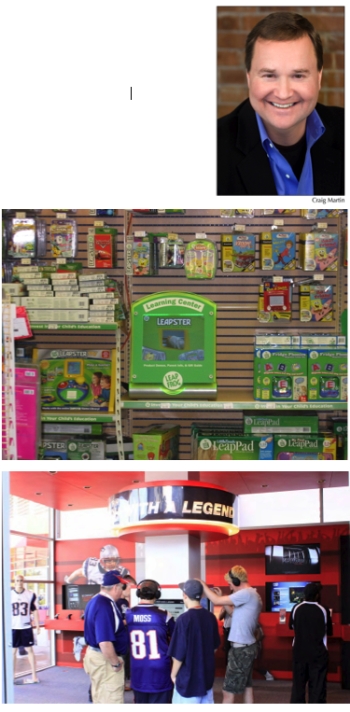Images:
1- Craig K. Martin
2- Leapfrog: Interactivity on the shelf, at the point of purchase, delivers key product information
3- Verizon: Attendees at a concert event engage with an interactive display
Touch screen applications are pervasive in our world. From the bank to the grocery store, we see them everywhere. They are even in our pockets and nestled into women’s handbags. We rely on touch screens to complete transactions, get on planes, and keep us informed and culturally aware. We also rely on them as our small, but powerful, daily information sources for any Google worthy question we have.
Today’s consumers are empowered unlike ever before when making purchasing decisions. Savvy marketers know that they have limited control over the results of a Google search or a barcode scan in an Amazon marketplace app. Forward-thinkers know they do have an opportunity to influence in the aisle, at the point-of-sale or at other daily decision points.
Interactive at Multiple & Many Locations
Interacting with touch screen technology has been transformative in our daily lives. I bet there are a few implementations that you take for granted in your day-to-day. In fact, the most successful kiosk implementation in history is the Automated Teller Machine (ATM).
Some implementations like kiosks at airline check-in or immigration are embraced by the public. Others, like self-check out at the grocery store have mixed reviews and are not universally accepted. Nevertheless, touch screen interactivity is woven into the fabric of our daily experiences. Pioneering implementations like the ATM have opened the gate to acclimate numerous sections of the consumer populace to using technology when they are seeking assistance or knowledge. They’ve helped to foster the opportunity and the willingness in the consumer to rely on technology to assist them in daily decision-making.
Driving the Individual to Act: Connecting with a Real Need
For marketers, the key is bringing the power of interactive touch points in line with the brand experience where it’s needed most; The Point of Decision. The Point of Decision is that place, typically right at the shelf where products are stored and merchandised. This is today’s battle ground. Television and other mass market mediums are generating demand and driving consumers to the stores, but the facts are, according to the Point of Purchasing Advertising Institute, that 7 out of 10 buying decisions are made IN STORE.
Marketers can’t rely solely on traditional methods to communicate their message. Packaging and POP displays are no longer enough to draw a consumer to an item on shelf and convince them to buy your product over your competitors’. However, you’ve got a captive audience within the aisle of a retail store. The consumer is there for a reason (usually) and willing to engage with your product or brand if given the chance. But, once they’re engaged with your touch screen implementation in aisle or on an end cap, what about it is going to impact their behavior? The quality of your content will make all the difference and you’ll want to make sure it’s casted to meet their specific needs.
Your audience is captive, your location is set, and now, what’s going to be on the screen? You’ve got to start with an excellent user interface. It takes a little know-how about human psychology and knowledge about ideal positioning of design and content to create a great user experience that moves consumers to purchase. What is it that you are offering the consumer that they aren’t going to get from their mobile device? Are you going to give them a brief interactive tour of your product line, are you going to tell them about what’s on sale or personally assist them to find the perfect product? You need to give the consumer something they can’t get elsewhere. Are you going to save them time, save them money, or make their life better? If not, you’re not going to attract or connect with the consumer– no matter what you’re selling or where your unit is.
Technology & Expertise for Roll Out
Once you understand the impact you can have, next is implementing a real solution. What is the right technology to support your user experience? What is the right deployment strategy? How and when do you update? Whether your project is an in-store or multi-branch deployment in the banking sector, you’ll need cost-effective answers to these and other questions as you roll-out to hundreds or thousands of locations. Most importantly you’ll need a team that’s dedicated to the life-span of the program. A skilled, experienced team can be the difference between success and failure of a digital merchandising program. The costs and stakes are high and there is no room for amateurs.
You want to improve the lives of consumers by giving them the convenience and crucial information they need in their everyday lives. With touch screen interactivity, you can harness the power of technology that’s already so pervasive in our daily lives. With a little expertise and tested strategies, you can implement a reliable solution that makes bottom line driving impact.
You can learn more on how to leverage the impact of daily touch points strategically in a session at DSE entitled "The Power of Interactive: From Drawing Crowds to Engaging Individuals."
Craig Martin has over 15 years of experience providing Fortune 500 brands and retailers with innovative digital merchandising solutions. He founded Reality Interactive, LLC. in 2004 and clients over the years include BMW, Callaway Golf, PepsiCo, Bose, Lego, Leapfrog and others.










